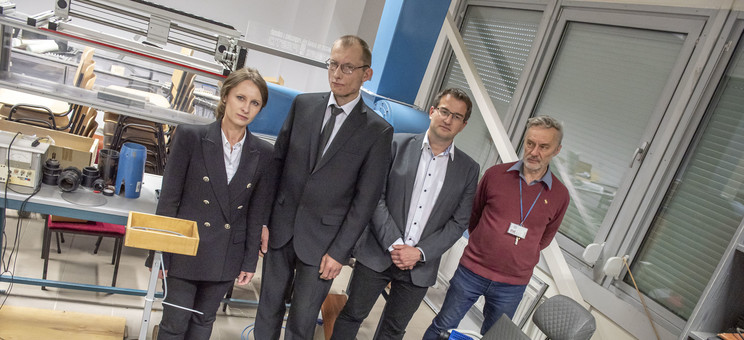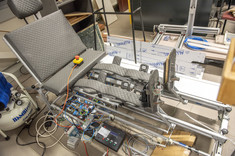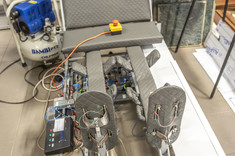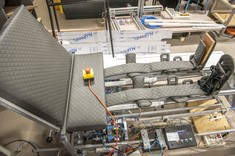Rehabilitation device with microprocessor control with pneumatic drive for passive exercises of lower limbs

The project entitled 'Rehabilitation device with microprocessor control and pneumatic drive for passive exercise of the lower limbs' authored by Marta Żyłka, PhD, Eng., and Zygmunt Szczerba, PhD, Eng., from the Department of Aerospace Engineering of the Faculty of Mechanical Engineering and Aeronautics, Marcin Biskup and Wojciech Żyłka, PhD, Eng., received a silver medal at the 15th International Invention and Innovation Show INTARG. The device is intended for patients with locomotor system dysfunctions, mainly for rehabilitation of knee and hip joints, and is used to restore mobility of lower limbs.
The project consists of two patents: patent no. Pat. 233326 for the invention "Device for rehabilitation of lower limbs" and patent no. Pat.240501 for the "Control system for speed and simultaneous extension of piston rods of two pneumatic cylinders" invention.
Description of the device
The rehabilitation device simulates the natural movement of limbs by means of actuators and additionally reactivates the fitness functions of patient's lower limbs. The control system used in the device enables simultaneous movement of two piston rods of pneumatic actuators, and the innovative control regulates the concurrent movement of two actuators. An important issue of the control system are two groups of throttle valves, which consist of four identical throttle valves appropriately scaled - set to different valve opening heights.
When extending the piston rods of the actuator, the position microcontroller reads the displacement difference between the two piston rods by means of potentiometric sensors. Depending on the displacement difference, the individual zones are switched on. The microcontroller reads the difference (zone) in displacement of the piston rods of the actuators and then controls the binary valves which are connected to the graduated throttle valves, switching them on accordingly.
The device is intended for patients with locomotor system dysfunctions, mainly for rehabilitation of knee and hip joints. It is used to restore the efficiency of lower limbs locomotor system by means of passive exercises. The simultaneous exercise of both lower limbs in passive and active exercises is intended, among others, to develop and maintain the full range of motion in joints, protect against muscle contractures and prevent bedsores.
Implementation
After consultation with experts in the field of rehabilitation, it was concluded that the device is primarily applicable to patients with neurological and orthopaedic-surgical problems, such as
- after fractures in the lower limb, after reconstructions with bone fusion and operations on joint capsule adhesions (due to reduced joint flexibility),
- after immobilisation due to damage to the joint capsule and periarticular structures (synovial membrane, bursae) of the knee and hip joint
- with enthesopathy (periarticular calcifications),
- after surgeries or plastic surgeries of the patellar bone of the knee joint,
- after inflammation of the tendons of the joints of the lower limb (after healing of the inflammation),
- after torsional fractures of the femoral neck,
- after the knee endoscopy (in the case of damage to knee joint structures),
- after stroke,
- after brain tumour surgery,
- after spinal cord injuries, especially in the thoracic part of the spine,
- with multiple sclerosis,
- with knee and hip replacement,
- with cerebral palsy,
- in long-term immobilisation.
This device is also very useful for rehabilitation of patients with severe course of the Covid-19 virus disease.
Rehabilitation undertaken too late results in long-term immobility of the limb. Therefore, it is important to carry out exercises from the first days of the disease or after the injury, with proper control, which will protect the patient from muscular atrophy and contractures, degeneration of joints, bedsores, reduce the risk of permanent disability and dependence on the environment.
The analysis of rehabilitation processes, especially of lower limbs, has shown the usefulness and significance of exercises that require simultaneous movement of both limbs of the patient. Very good results are given by simultaneous exercise of both limbs – healthy and paralysed, because the movements of the healthy limb contribute to the increase of muscle potential in the paralysed limb.










